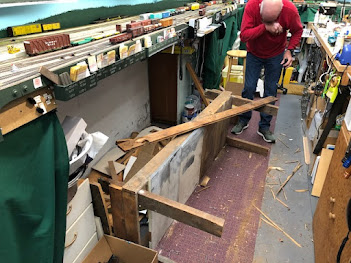Sometimes you have to demolish before you can construct. When we moved into this house I needed to tear down three walls in the basement to clear the way for the model railroad to come. But I neglected to tear down an old bulky solid-as-a rock workbench/shelf unit that the previous owner had built there. After thirty years of thinking about it, last week we got out the hammers and other deconstruction tools and tore the thing apart. There was no way to imagine hauling it up the basement stairs, even though some other homeowner might have found it useful.
What I realized in the intervening thirty years is that model railroading is both an art and a manufacturing plant. We need a work station for electronics like DCC decoders, servos and LCC setups. We need a work station for building kits for cars, bridges and structures. And we need a paint shop next to the spray booth for managing the various finishes for all of the above. Not to mention applying decals and building open loads. So we took the plunge and demolished the old workbench.
Here it is in pieces,
And here is the space it left behind:
To the right and left of the space are old surplus kitchen cabinets from previous remodel jobs, that also are sub-optimal storage solutions at best, and will probably go too. And I don't know what to do with the pile of scraps on the floor. A lot of brainstorming is going on right now. But with nine to twelve or even fifteen linear feet to work with, and a depth of just over two feet, we should be able to come up with some specialized workstations to make the railroad a lot easier to build and maintain. We'll keep you posted, and let us know if you have any good ideas for how juggle work space, tools and supplies for specialized tasks like we model railroaders engage in....


































